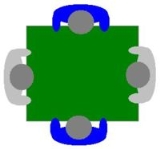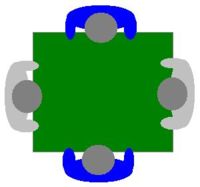
Tarneeb
Encyclopedia
Tarneeb is a popular plain trick-taking card game
played in various middle eastern countries, most notably in the countries of the Fertile Crescent
and Tanzania
. The game may be considered an variation of Whist
.
is used, each suit ranking in the usual way from Ace (high) down to two (low). The game is played in a counterclockwise fashion. The teams stay together for all the games of a set. In tarneeb tournament, at the end of a set, the losing team is replaced for the next set.
The two members of each team are seated across each other, often on a table in such a way that no player can see the cards of other players (see seating charting image). Either player of a team may collect the winning tricks.
The first dealer is chosen at random and after each hand the turn to deal passes to the right. The cards are shuffled and cut by the player to the dealer's left, and are all dealt out beginning with player to the dealer's right, one at a time or in groups of thirteen (13), so that everyone has 13 cards.
 The bidding begins with the first player to the right of the dealer and continues counter-clockwise. It consists of a number of tricks seven or above. A bid of more tricks outranks any bid of fewer tricks.
The bidding begins with the first player to the right of the dealer and continues counter-clockwise. It consists of a number of tricks seven or above. A bid of more tricks outranks any bid of fewer tricks.
Each person can bid only once, eliminating the option for a player to raise their bid. In addition, the dealer, who bids last, has the option to match, rather than raise the highest bid.
The individual declarer leads to the first trick. Players counterclockwise must follow suit
if they can; a player who has no cards of the suit led can play any card. A trick is won by the highest tarneeb (trump) in it, if any. If there are no tarneebs in the trick, the highest card of the suit led wins it. The winner of a trick leads to the next.
A team can win a game by bidding for 13 tricks, but they have to declare it at the bidding time by calling for a "game" (بالدق).
Card game
A card game is any game using playing cards as the primary device with which the game is played, be they traditional or game-specific. Countless card games exist, including families of related games...
played in various middle eastern countries, most notably in the countries of the Fertile Crescent
Fertile Crescent
The Fertile Crescent, nicknamed "The Cradle of Civilization" for the fact the first civilizations started there, is a crescent-shaped region containing the comparatively moist and fertile land of otherwise arid and semi-arid Western Asia. The term was first used by University of Chicago...
and Tanzania
Tanzania
The United Republic of Tanzania is a country in East Africa bordered by Kenya and Uganda to the north, Rwanda, Burundi, and the Democratic Republic of the Congo to the west, and Zambia, Malawi, and Mozambique to the south. The country's eastern borders lie on the Indian Ocean.Tanzania is a state...
. The game may be considered an variation of Whist
Whist
Whist is a classic English trick-taking card game which was played widely in the 18th and 19th centuries. It derives from the 16th century game of Trump or Ruff, via Ruff and Honours...
.
History
Tarneeb was probably inspired by many other Arabic card games, though many different nations throughout the Middle East claim that Tarneeb was created in their respective countries. Historically Tarneeb can be traced back to Bla'd Al Sham, more specifically Syria, Lebanon, Jordan, and Palestine, however the game seems to have truly flourished only from the early 18th century on.The game
The aim of tarneeb is to win a set of continuous hands. There are four players in partnerships of two teams. A standard 52 card deckPlaying card
A playing card is a piece of specially prepared heavy paper, thin cardboard, plastic-coated paper, cotton-paper blend, or thin plastic, marked with distinguishing motifs and used as one of a set for playing card games...
is used, each suit ranking in the usual way from Ace (high) down to two (low). The game is played in a counterclockwise fashion. The teams stay together for all the games of a set. In tarneeb tournament, at the end of a set, the losing team is replaced for the next set.
The two members of each team are seated across each other, often on a table in such a way that no player can see the cards of other players (see seating charting image). Either player of a team may collect the winning tricks.
The first dealer is chosen at random and after each hand the turn to deal passes to the right. The cards are shuffled and cut by the player to the dealer's left, and are all dealt out beginning with player to the dealer's right, one at a time or in groups of thirteen (13), so that everyone has 13 cards.
Bidding

Each person can bid only once, eliminating the option for a player to raise their bid. In addition, the dealer, who bids last, has the option to match, rather than raise the highest bid.
- Some players actually use the option of telling your partner how good are you cards i.e. , helpful, not helpful at all.
Playing
The objective of the bidding team is to take at least the number of tricks that they bid. The objective of the other team is to hinder the declarer team from reaching their declared bid.The individual declarer leads to the first trick. Players counterclockwise must follow suit
Suit (cards)
In playing cards, a suit is one of several categories into which the cards of a deck are divided. Most often, each card bears one of several symbols showing to which suit it belongs; the suit may alternatively or in addition be indicated by the color printed on the card...
if they can; a player who has no cards of the suit led can play any card. A trick is won by the highest tarneeb (trump) in it, if any. If there are no tarneebs in the trick, the highest card of the suit led wins it. The winner of a trick leads to the next.
Playing exceptions
- In some regions, the declarer must start the first trick with his declared tarneeb suit. But in most cases they dont.
Scoring
Once all thirteen tricks are played, the scores of the two sides are calculated by adding the tricks each side has won. If the declarer team meets or exceed the number of bidded tricks, then they get the number of tricks they have, otherwise, they lose the bid number (subtracted from their score) and the opposing team gets the number of tricks they complete. It is possible, therefore, to have a negative score at some point. The set ends when one of the teams reaches thirty-one (31) and the losing team is replaced for the next set.A team can win a game by bidding for 13 tricks, but they have to declare it at the bidding time by calling for a "game" (بالدق).
Game strategies
- Keep Tarneeb Count: Every player should know how many tarneebs are out and how many are left at any point in the game. This is most crucial for the declarer who should always know how many tarneebs are out.
- Tashleeh: If you are the declarer, try to eliminate as many tarneebs from the game as possible.
- Ta'leem: If your partner is the declarer and you run out of tarneebs, signal to your partner what suit you want him to follow on the next trick by using a low card of that suit.
- Hints: If you want your partner to return the same suite on the next turn, slam the card on the table as you play. Note that this practice is not allowed in some areas and generally frowned upon as not very professional behavior.
- Na'f: When you finish a suit, throw the last card with a (flick) which hints your partner. This also is not always allowed.
- Second Lowest/Third Highest: for any trick, a good rule of thumb is for the second player to use the lowest card, and the third player to use the highest card.

